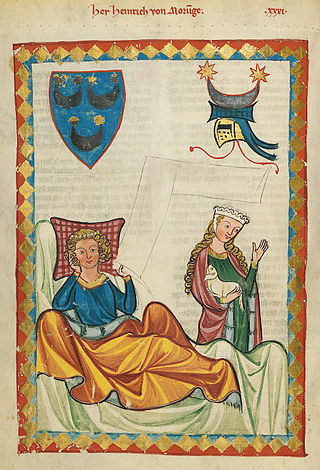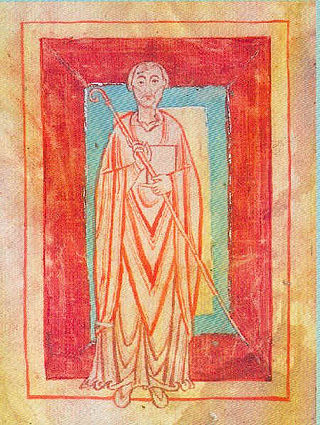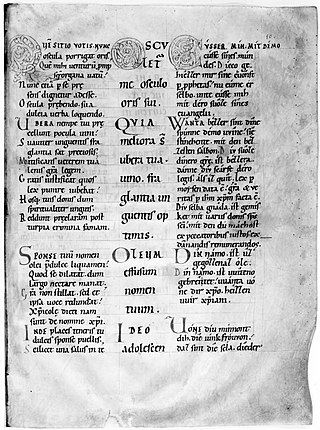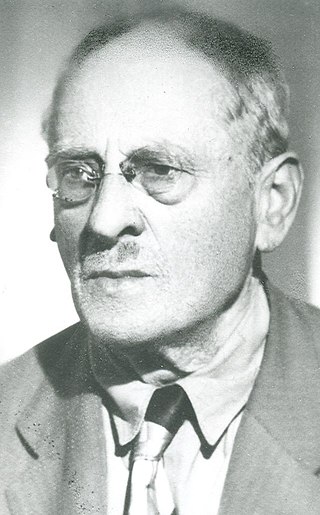Related Research Articles

The Abbey of Saint Gall is a dissolved abbey (747–1805) in a Catholic religious complex in the city of St. Gallen in Switzerland. The Carolingian-era monastery existed from 719, founded by Saint Othmar on the spot where Saint Gall had erected his hermitage. It became an independent principality between 9th and 13th centuries, and was for many centuries one of the chief Benedictine abbeys in Europe. The library of the Abbey is one of the oldest monastic libraries in the world.

Lorsch Abbey, otherwise the Imperial Abbey of Lorsch, is a former Imperial abbey in Lorsch, Germany, about 10 km (6.2 mi) east of Worms. It was one of the most important monasteries of the Carolingian Empire. Even in its ruined state, its remains are among the most important pre-Romanesque–Carolingian style buildings in Germany.

Heinrich von Morungen was a Minnesinger, whose 35 surviving Middle High German songs are dated on both literary and biographical grounds to around the period 1190–1200. Alongside Walter von der Vogelweide and Reinmar he is regarded as one of the most important Minnesänger: he was "the most colourful, passionate, tender and musical of the Minnesänger" and his work "marks a new and brilliantly effective stage in the development of the German lyric."

Reichenau Abbey was a Benedictine monastery on Reichenau Island. It was founded in 724 by the itinerant Saint Pirmin, who is said to have fled Visigothic Spain ahead of the Moorish invaders, with patronage that included Charles Martel, and, more locally, Count Berthold of the Ahalolfinger and the Alemannian Duke Santfrid I (Nebi). Pirmin's conflict with Santfrid resulted in his leaving Reichenau in 727.

William of Hirsau was a Benedictine abbot and monastic reformer. He was abbot of Hirsau Abbey, for whom he created the Constitutiones Hirsaugienses, based on the uses of Cluny, and was the father of the Hirsau Reforms, which influenced many Benedictine monasteries in Germany. He supported the papacy in the Investiture Controversy. In the Roman Catholic Church, he is a Blessed, the second of three steps toward recognition as a saint.

Zwiefalten Abbey is a former Benedictine monastery situated at Zwiefalten near Reutlingen in Baden-Württemberg in Germany. Zwiefalten is on the Upper Swabian Baroque Route.

Hirsau Abbey, formerly known as Hirschau Abbey, was once one of the most important Benedictine abbeys of Germany. It is located in the Hirsau borough of Calw on the northern slopes of the Black Forest mountain range, in the present-day state of Baden-Württemberg. In the 11th and 12th century, the monastery was a centre of the Cluniac Reforms, implemented as "Hirsau Reforms" in the German lands by William of Hirsau. The complex was devastated during the War of the Palatine Succession in 1692 and not rebuilt. The ruins served as a quarry for a period of time.

Göttweig Abbey is a Benedictine monastery near Krems in Lower Austria. It was founded in 1083 by Altmann, Bishop of Passau.

Neresheim Abbey or the Abbey of Saints Ulrich and Afra, Neresheim is located above the town of Neresheim in Baden-Württemberg, southern Germany. It is now a Benedictine monastery and is part of the Beuronese Congregation.

Williram of Ebersberg was a Benedictine Abbot. He is best known for his 'Expositio in Cantica Canticorum', a complex commentary of the Song of Songs which includes an Old High German translation and a Latin verse paraphrase.

Ellwangen Abbey was the earliest Benedictine monastery established in the Duchy of Swabia, at the present-day town of Ellwangen an der Jagst, Baden-Württemberg, about 100 km (60 mi) north-east of Stuttgart.

The Zimmern Chronicle is a family chronicle describing the lineage and history of the noble family of Zimmern, based in Meßkirch, Germany. It was written in a Swabian variety of Early New High German by Count Froben Christoph of Zimmern (1519–1566). The chronicle is an eminent historical source of information about 16th century nobility in South-West Germany, its culture and its values. It is also an important literary and ethnological source for its many folkloristic texts. The text has survived in two manuscripts, both in possession of the Württembergische Landesbibliothek in Stuttgart.

Herrenalb Abbey is a former Cistercian monastery in the present Bad Herrenalb in Baden-Württemberg, Germany.

Oskar Rescher, also known as Osman Reşer, was a prolific German-Turkish scholar in Arabic, Persian, and Turkish literature who specialized in pre-Islamic Arabic poetry and Ottoman studies.

The House of Kirchberg were a Swabian aristocratic family, once wealthy that held the County of Kirchberg, mainly south of Ulm, on the right and left of the Iller. They are difficult to document, but at the end of the early Middle Ages and the beginning of the High Middle Ages they may have had a significance that went beyond regional power. By the end of the 12th century, the family had split into two lines, later into three, becoming impoverished towards the end of the Middle Ages and dying out in 1510 after the sale of their possessions and rights.
Amor und Psyche is an opera (singspiel) in four acts composed by Ludwig Abeille to a German libretto by Franz Carl Hiemer(1768–1822). Based on the story of Cupid and Psyche, the opera premiered on January 18, 1800, at the Hoftheater (Herzöglichestheater) in Stuttgart. Amor und Psyche was popular in Germany in its day and a version of the score for voice and piano was published by Breitkopf & Härtel. Franz Carl Hiemer went on to write the libretto for Abeille's third opera, Peter und Ännchen (1809) as well as the libretti for Carl Maria von Weber's operas Silvana and Abu Hassan.
Bertha of Rheinfelden, countess of Kellmünz, was the daughter of Rudolf of Rheinfelden and wife of Ulrich X of Bregenz.
Ulrich X was Count of Bregenz from 1079 to his death in 1097.
Berthold of Zwiefalten was a German Benedictine monk who thrice served as abbot of Zwiefalten Abbey and wrote its early history.
References
- 1 2 Szymon Wieczorek (2016), "Ortlieb of Zwiefalten", in Graeme Dunphy and Cristian Bratu (eds.), Encyclopedia of the Medieval Chronicle (Brill Online), consulted 23 July 2020.
- ↑ J. F. Hamburger (1990), "Review of Annegret Butz, Katalog der illuminierten Handschriften der Württembergischen Landesbibliothek Stuttgart, Bd. 2, Teil 2: Die Romanischen Handschriften der Württembergischen Landesbibliothek Stuttgart, Verschiedene Provenienzen", Quaerendo, 20 (3), doi:10.1163/157006990x00210 , p. 229.
- 1 2 3 Luitpold Wallach (1957), "Berthold of Zwiefalten's Chronicle: Reconstructed and Edited with an Introduction and Notes", Traditio, 13: 153–248, doi:10.1017/s0362152900007959 .